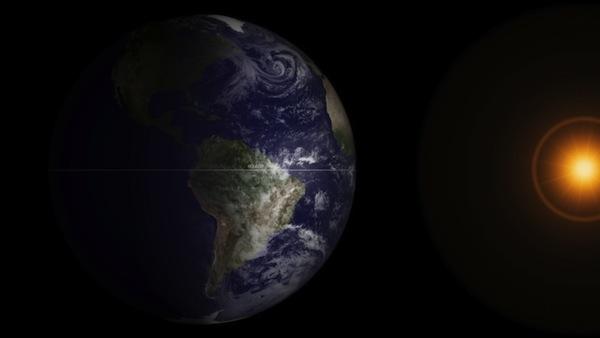Source: Indian Country Today Media Network, March 20, 2013

Spring may have arrived on Earth with a winterish whimper, but what’s happening in the sky is preordained.
At 7:02 a.m. Eastern Time, the plane emanating from Mother Earth’s Equator was also bisecting her guiding star, the two poles exactly perpendicular.
Less than an hour later, far above the Earth, at 7:45 Eastern Time, the National Oceanic and Atmospheric Administration’s GOES-13 satellite captured this full disk image of Earth. The agency superimposed an image of the sun at its relative position and released a stunning photo.
On the ground it was nothing special, even generating complaints about a faux spring that did not generate a whit of warmth. But that did nothing to change what is going on astronomically between Mother Earth’s orbit and her guiding star. In fact, it’s more like New Year’s.
“Although popularly described as ‘the first day of spring’ in the Northern Hemisphere, the annual event is actually much more important than that,” reports space.com, explaining the significance of the sun’s position in the sky in relation to earth’s ecliptic. “More than any other event, it marks the beginning of the astronomical year.”

On this day the sun switches from the south to the north side of the celestial equator during the spring equinox, Space.com explained. Above is a look at what the sun’s position would be against the stars, if we were to dim our star so as to see it in context.
We are quite possibly spoiled from last year, when March temperatures were at a record high, the Washington Post said. This year they are unseasonably cool. However, those warm spring days are just a matter of time.
“Yet no matter what the weather outside, the spring equinox is a reminder that incoming sunlight is significantly stronger as the Earth’s northern hemisphere begins to tilt toward the sun,” the Washington Post said. “Even as winter overstays its welcome for some, we now see more daylight than darkness. That means spring can’t be far behind.”
Read more at http://indiancountrytodaymedianetwork.com/2013/03/20/first-day-spring-skies-have-it-noaa-catches-vernal-equinox-space-148274
